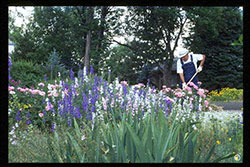The easiest way to minimize landscape maintenance is to plant gardens adapted to the local environment. Weeding, pruning, proper fertilizer and irrigation system adjustments are some of the maintenance practices that need to be kept up with. Aerate the lawn twice a year, spring and fall, to help the water permeate into the root zone.

Xeriscapes, or water-efficient gardens, are earth friendly because they feature plants that thrive on less water. When using plants that require more water, locate them in areas where they can be watered efficiently. Xeriscapes, then, are well-planned, low-maintenance landscapes that are environmentally attuned and require minimal watering, weeding, fertilizing, pest control, and pruning.
Watering can be reduced after one or two years when transplanted plants are established. Less water applied to mature xeriscapes results in fewer weeds and reduced maintenance. Mulch initially covers the ground minimizing weed growth, and when plants begin to mature, their growth covers the soil leaving little light to promote weed growth.
Reduced watering means less plant growth, and less pruning. Adapted plants generally don’t require large amounts of fertilizer. As with any landscape, however, pests can become a problem that require some management.
Xeriscapes require less fossil fuel for mowers and other power maintenance equipment. This not only conserves energy, it means less air pollution.
It’s fun and refreshing to spend time in a xeriscape. While no landscape is totally maintenance free, regionally adapted xeriscapes are as close as you can get.
For more information, see the following Colorado State University Extension fact sheet(s).



